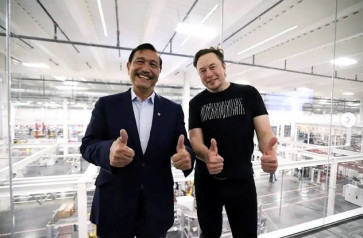Exporters map out new markets, focus on S.E. Asia
Exports of completely built-up (CBU) cars from Indonesia may be on a rebound after a painful dip in 2009; but challenges remain for things to get back to pre-crisis levels, the Indonesian Automotive Industry Association (Gaikindo) says
Change Size

E
xports of completely built-up (CBU) cars from Indonesia may be on a rebound after a painful dip in 2009; but challenges remain for things to get back to pre-crisis levels, the Indonesian Automotive Industry Association (Gaikindo) says.
Gaikindo estimates the exports of cars will grow by 30 percent from a reported 56,669 last year, considerably lower than 100,982 in 2008.
Deputy chairman for the association Jongkie D. Sugiarto told The Jakarta Post recently the global economic recovery would play a decisive role in the recovery of automobile exports.
Jongkie said global car manufacturers such as Toyota in Japan and Hyundai in South Korea, were targeting new export destinations for their production facilities in Southeast Asia, including Indonesia.
The Southeast Asian market is unique to car manufacturers as it serves as both a production base as well as an emerging consumer market, with demand on a positive growth trajectory, reflecting sound economic policies.
Jongkie, who is also the president director of Hyundai Mobil Indonesia, said the economic resilience of the region was strengthened by the implementation of the free trade pact among ASEAN economies.
AFTA has lifted the 5 percent tax on cars and parts traded among the founding ASEAN countries — Thailand, Malaysia, Singapore, Brunei, Philippines and Indonesia.
“Currently, car manufacturers produce one model in one country, so there will be no redundancy, every country can complement each other,” Jongkie said.
The chief of external affairs for PT Toyota Motor Manufacturing Indonesia, Irwan Priyantoko, said that the robust economic performance of ASEAN had allowed the company to regenerate exports this year.
“Last year, we had to stop exporting Fortuner [Toyota’s SUV model] due to the global financial crisis,” he said. In clarification of the Post’s previous report, Irwan said Toyota had never stopped exporting SUVs from Thailand.
Although expecting growth in export destinations in ASEAN and the Middle East, Irwan said it was hard to pin down when Indonesia’s exports might top the 2008 figures.
Amelia Tjandra, a marketing director at Astra Daihatsu Motor, argues that while opportunities may abound in Southeast Asia, the real recovery for Indonesian car exports will be determined by how fast developed economies can crank up domestic demand.
Amelia said that even though the implementation of the AFTA had opened up ample opportunities for Indonesia to increase its market share, the country would still face a tough challenge from Thailand, the strongest automobile and components exporter in the region.
“But, we believe that we can do better than last year,” she told the Post.
In the first half of this year, Daihatsu has exported 7,133 automobiles, up 4 percent from 6,858 in the same period last year. The company exports GranMax, Town Ace and Lite Ace models to several countries in Asia and Africa including Japan, Brunei, Malaysia, Saudi Arabia, Oman, Egypt, South Africa, the United Arab Emirates, Algeria, Yemen and Kuwait.
“We are committed to continuously develop our exports. We have also made Indonesia our production base both for domestic sales and exports,” Amelia said.
Trade Ministry data shows Indonesia’s automotive export value reached US$1.62 billion in 2006 and 2.04 billion in 2007. In 2008, automobile export value hit its highest record, $2.73 billion, before falling sharply to 1.73 in 2009. In the first half of this year, automobile export value reached $1.32 billion. (rdf)









